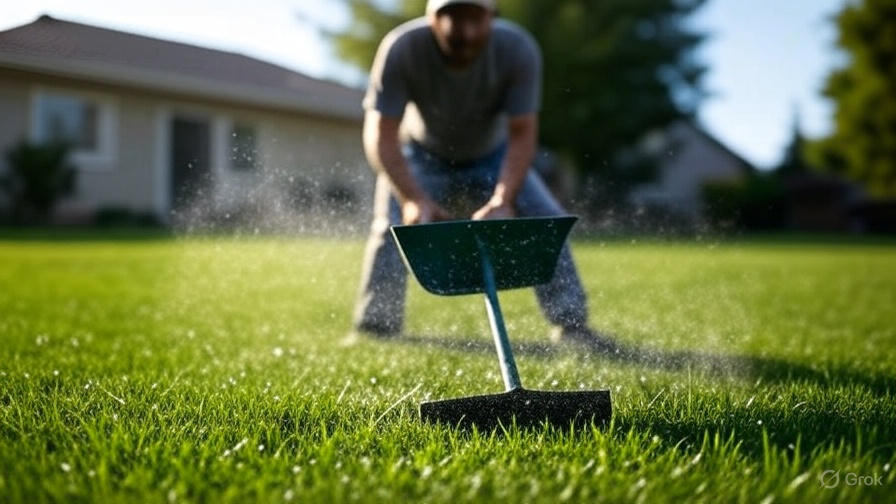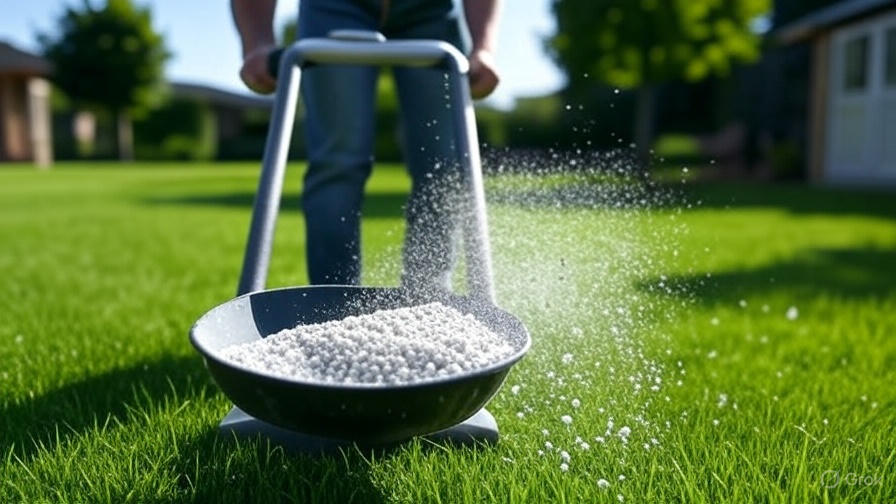How to Add Nitrogen to Your Lawn?
A lush, green lawn starts with proper nutrition, and nitrogen serves as the most critical nutrient for grass health. Your lawn craves this essential element to develop thick, vibrant blades that resist disease and withstand foot traffic. Without adequate nitrogen levels, grass becomes pale, thin, and susceptible to weeds and pests.
Most homeowners struggle with yellowing patches, slow growth, and sparse coverage because they don’t know how to properly feed their lawns. The good news is that adding nitrogen to your lawn doesn’t require professional expertise or expensive equipment. You can transform your yard into a neighborhood showpiece by following proven methods and timing strategies.
Why Your Lawn Needs Nitrogen
Nitrogen fuels chlorophyll production, the green pigment that gives grass its healthy color. This vital nutrient drives photosynthesis, allowing your lawn to convert sunlight into energy for growth and repair. Grass uses nitrogen to build proteins, enzymes, and amino acids that strengthen cell walls and promote dense growth.
Your soil naturally contains some nitrogen, but rain, irrigation, and microbial activity constantly deplete these reserves. Grass roots can only access nitrogen in specific forms, primarily nitrate and ammonium. These water-soluble compounds move through soil easily, which means regular replenishment becomes necessary for sustained lawn health.
Cool-season grasses like fescue, bluegrass, and ryegrass require more nitrogen than warm-season varieties such as Bermuda, Zoysia, and St. Augustine. However, all grass types benefit from consistent nitrogen feeding throughout their active growing seasons.
Signs Your Lawn Lacks Nitrogen
Recognizing nitrogen deficiency early allows you to correct problems before they become severe. Grass exhibits several telltale symptoms when nitrogen levels drop below optimal ranges.
Yellow or pale green coloring appears first in older grass blades, starting at the tips and spreading downward. This chlorosis occurs because plants transport available nitrogen to newer growth, leaving mature leaves without adequate nutrition. The yellowing typically begins in high-traffic areas where grass experiences the most stress.
Slow growth becomes apparent when you notice longer intervals between mowing sessions. Nitrogen-deficient grass grows at roughly half the rate of properly fertilized turf. Blade development slows, and new shoots emerge less frequently from crown areas.
Thin, sparse coverage develops as individual grass plants struggle to produce new tillers and rhizomes. Your lawn may look patchy or bare in spots where healthy grass should fill in naturally. Weeds often invade these weak areas because they can outcompete stressed grass for resources.
Poor recovery from foot traffic, pet damage, or environmental stress indicates insufficient nitrogen reserves. Healthy, well-fed grass bounces back quickly from minor damage, while nitrogen-starved turf remains flattened or brown for extended periods.
Testing Your Soil’s Nitrogen Levels
Accurate soil testing provides the foundation for successful nitrogen management. Professional soil analysis reveals current nitrogen levels, pH balance, and other essential nutrients that affect grass health.
Contact your local cooperative extension office to obtain soil testing kits and instructions. These services typically cost $15-30 and provide detailed nutrient analysis with specific fertilizer recommendations. Many extension offices also offer digital soil maps showing typical nutrient profiles for your area.
Home soil test kits offer quick results but provide less detailed information than professional analysis. Digital pH meters and nitrogen test strips give instant readings for immediate decision-making. However, these tools work best for general monitoring rather than precise fertilizer planning.
Take soil samples from multiple locations across your lawn, avoiding areas near sidewalks, driveways, or recent fertilizer spills. Collect samples from the top 4-6 inches of soil where grass roots concentrate their feeding activity. Mix samples from different areas to create a representative composite for testing.
Spring and fall provide the best timing for soil testing because these seasons precede major fertilization periods. Test results remain valid for 2-3 years unless you make significant soil amendments or experience unusual weather patterns.
Types of Nitrogen Fertilizers
Different nitrogen sources offer distinct advantages depending on your lawn’s needs, climate conditions, and maintenance preferences. Each type releases nitrogen at varying rates, affecting how quickly grass responds and how long benefits persist.
Quick-Release Nitrogen Fertilizers
Synthetic fertilizers like ammonium sulfate and urea provide immediate nitrogen availability to grass roots. These products typically contain 20-46% nitrogen in water-soluble form that plants can absorb within days of application.
Quick-release fertilizers produce rapid greening and growth spurts, making them ideal for correcting severe deficiencies or preparing lawns for special events. However, frequent applications become necessary because nitrogen leaches from soil within 4-6 weeks.
Liquid nitrogen fertilizers offer the fastest uptake because grass absorbs nutrients through both roots and leaf surfaces. Spray applications provide uniform coverage and precise nutrient control, though they require more frequent reapplication than granular products.
Slow-Release Nitrogen Options
Controlled-release fertilizers use polymer coatings or chemical bonds to gradually release nitrogen over 8-12 weeks. These products cost more upfront but provide consistent nutrition with fewer applications and reduced risk of burning grass.
Sulfur-coated urea represents one popular slow-release option that responds to soil temperature and moisture conditions. Nitrogen release accelerates during warm, wet periods when grass grows most actively, providing natural synchronization between nutrient supply and plant demand.
Organic nitrogen sources like compost, blood meal, and fish emulsion release nutrients slowly as soil microorganisms break down organic matter. These products improve soil structure while feeding grass, though they contain lower nitrogen percentages than synthetic alternatives.
Organic Nitrogen Sources
Compost provides sustainable nitrogen along with beneficial microorganisms that improve soil health. Well-aged compost typically contains 1-3% nitrogen in slow-release form, making it nearly impossible to over-apply or burn grass.
Blood meal offers higher nitrogen content (12-15%) in organic form that becomes available as soil bacteria decompose the protein-rich material. This byproduct of meat processing works well for spot-treating deficient areas or boosting nitrogen levels before peak growing seasons.
Grass clippings supply free nitrogen when left on the lawn after mowing. Fresh clippings contain approximately 4% nitrogen by weight and decompose quickly in warm, moist conditions. This practice, called grasscycling, can provide up to 25% of your lawn’s annual nitrogen needs.

Best Times to Apply Nitrogen
Timing nitrogen applications with your grass’s natural growth cycles maximizes nutrient uptake and minimizes waste. Different grass types have distinct seasonal patterns that determine optimal fertilization schedules.
Cool-Season Grass Timing
Cool-season grasses experience peak growth during spring and fall when temperatures range between 60-75°F. These varieties slow their growth during hot summer months and enter dormancy when temperatures consistently drop below 50°F.
Apply the heaviest nitrogen feeding in early fall (September-October) when cool-season grasses resume active growth after summer stress. Fall applications help grass recover from heat damage, develop strong root systems, and store energy for winter survival.
Spring nitrogen applications (April-May) should be moderate to avoid excessive top growth during stressful summer months. Light feeding helps grass green up and fill in winter damage without creating lush growth that requires extra water and maintenance.
Avoid nitrogen applications during peak summer heat (July-August) when cool-season grasses naturally slow their growth. Summer fertilization can stress grass and promote disease development in hot, humid conditions.
Warm-Season Grass Schedule
Warm-season grasses thrive in temperatures between 80-95°F and grow most actively from late spring through early fall. These varieties enter dormancy when soil temperatures drop below 60°F and turn brown during winter months.
Begin nitrogen feeding in late spring (May-June) when soil temperatures consistently reach 65°F and grass shows signs of active growth. Early applications help warm-season grass recover from winter dormancy and establish thick coverage before peak summer heat.
Continue regular feeding through summer months when warm-season grasses maintain peak growth rates. These varieties can handle heavier nitrogen applications during hot weather without the stress experienced by cool-season types.
Stop nitrogen applications 6-8 weeks before your area’s first expected frost to allow grass to prepare for dormancy naturally. Late-season nitrogen can delay cold hardening and increase winter damage susceptibility.
Application Methods That Work
Proper application technique ensures even nutrient distribution and prevents fertilizer burn or streaking. Different application methods suit various lawn sizes, fertilizer types, and equipment availability.
Granular Fertilizer Application
Broadcast spreaders provide the most efficient method for applying granular nitrogen fertilizers to large lawns. Drop spreaders offer precise control but require overlapping passes to ensure complete coverage. Rotary spreaders cover ground faster but may create uneven distribution patterns on windy days.
Calibrate your spreader before each application by measuring the actual spread pattern and application rate. Most fertilizer bags include spreader settings, but variations in product density and spreader condition can affect actual delivery rates.
Apply granular fertilizer when grass is dry but soil contains adequate moisture for nutrient activation. Water lightly after application if rain isn’t expected within 24 hours, but avoid heavy irrigation that could wash nutrients away before grass roots absorb them.
Create application patterns that prevent streaking or missed areas. Work in parallel strips across your lawn, slightly overlapping each pass to ensure complete coverage. Change directions for subsequent applications to prevent wheel tracking and compaction.
Liquid Nitrogen Applications
Spray applications allow precise nutrient control and rapid grass uptake through both root and foliar absorption. Mix liquid fertilizers according to label directions, using proper spray equipment to ensure uniform coverage.
Tank sprayers work well for larger lawns, while hose-end applicators provide convenience for smaller areas. Pump sprayers offer the most control for spot treatments or precise application around landscape features.
Apply liquid nitrogen during calm weather conditions to prevent drift onto walkways, driveways, or ornamental plants. Early morning or late afternoon applications reduce evaporation and allow better nutrient absorption before dew formation or irrigation.
Rinse spray equipment thoroughly after each use to prevent corrosion and clogging. Clean nozzles and filters regularly to maintain consistent spray patterns and application rates.
Calculating the Right Amount
Proper nitrogen calculation prevents over-fertilization while ensuring your lawn receives adequate nutrition. Most established lawns require 2-4 pounds of actual nitrogen per 1,000 square feet annually, divided among multiple applications.
Measure your lawn area accurately by breaking complex shapes into rectangles, triangles, and circles. Subtract areas occupied by driveways, sidewalks, flower beds, and other non-grass features to determine actual turf coverage.
Read fertilizer labels carefully to determine actual nitrogen content rather than total bag weight. A 20-5-10 fertilizer contains 20% nitrogen, meaning a 50-pound bag provides 10 pounds of actual nitrogen. Divide this amount by your lawn’s square footage to determine coverage area.
Calculate individual application rates based on your lawn’s seasonal needs and the fertilizer’s release characteristics. Quick-release fertilizers should provide 0.5-1 pound of nitrogen per 1,000 square feet per application, while slow-release products can safely deliver 1-2 pounds per application.
Keep detailed records of application dates, products used, and rates applied. This information helps you track annual nitrogen totals and adjust future applications based on grass response and seasonal conditions.
Common Application Mistakes to Avoid
Many homeowners inadvertently damage their lawns through improper nitrogen application techniques or timing. Learning from these common errors saves time, money, and prevents grass injury.
Over-fertilization represents the most frequent nitrogen mistake, causing rapid growth, increased water requirements, and greater disease susceptibility. Excessive nitrogen also promotes thatch buildup and reduces root development as grass focuses energy on leaf production.
Uneven application creates striped patterns of dark green and light green grass that persist for months. Calibrate spreaders properly and maintain consistent walking speed to prevent these unsightly patterns.
Applying nitrogen to wet grass increases the risk of fertilizer burn because dissolved nutrients concentrate on leaf surfaces. Wait for morning dew to evaporate or delay application until grass blades dry completely.
Fertilizing dormant grass wastes nitrogen and may harm the environment through runoff and leaching. Cool-season grasses don’t actively absorb nutrients during summer dormancy, while warm-season varieties remain inactive during winter months.
Ignoring weather forecasts can lead to nutrient loss or grass damage. Heavy rain within 24 hours of application washes nitrogen away before roots absorb it, while hot, dry conditions increase burn risk from concentrated fertilizer salts.
Maintaining Long-Term Lawn Health
Sustainable nitrogen management requires balancing immediate results with long-term soil and grass health. Consistent, moderate feeding produces better results than sporadic heavy applications that stress grass and waste nutrients.
Integrate organic matter into your fertilization program to improve soil structure and nutrient retention. Compost, aged manure, and leaf mold increase the soil’s ability to hold nitrogen and other nutrients while supporting beneficial microbial activity.
Practice proper mowing techniques to reduce nitrogen requirements and improve grass health. Maintain blade height at the upper end of your grass type’s recommended range to promote deep root development and drought tolerance.
Water deeply but infrequently to encourage nitrogen uptake and root growth. Light, frequent irrigation keeps nutrients in the upper soil layer where they’re vulnerable to evaporation and runoff.
Monitor grass response to nitrogen applications and adjust rates based on actual performance rather than generic recommendations. Healthy grass color, moderate growth rates, and good density indicate proper nutrition levels.
Consider soil pH when planning nitrogen applications because grass can only access nutrients within specific pH ranges. Most grass types prefer slightly acidic to neutral soil (pH 6.0-7.0) for optimal nutrient uptake.
Your lawn’s nitrogen needs will change over time based on grass maturity, soil conditions, and environmental factors. Regular soil testing every 2-3 years helps you adjust fertilization programs to maintain optimal grass health while protecting water quality and minimizing environmental impact.
The investment in proper nitrogen management pays dividends through reduced maintenance costs, fewer pest problems, and increased property value. A well-fed lawn requires less water, resists disease naturally, and provides years of enjoyment for your family while contributing to your neighborhood’s overall appeal.







